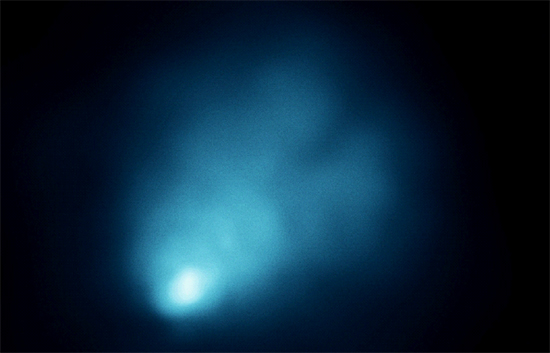
Colliding galaxy clusters, pinching Birkeland currents, or a falling Doughboy? Credit: NASA/CXC/Rutgers/J.Hughes et al.
Jan 10, 2012
El Gordo is so called because it is the biggest, brightest, and hottest pair of colliding galaxy clusters known to astronomers.
Astronomers “know” that El Gordo is over 7 billion light-years from Earth. This knowledge derives from the amount by which El Gordo’s light is shifted toward the red end of the visual spectrum, called redshift. That redshift is an indicator of distance is an indisputable fact. It is indisputable because, ever since Halton Arp was driven from the field in 1983 for disputing it, anyone who tries to dispute it is denied telescope time, refused publication, and blacklisted from employment.
Of course, if redshift were intrinsic, as Arp proposed, El Gordo would likely be nearby, small, faint, and cool.
Seeing (the sensation) is absolute and ambiguous: You can be sure that you see patches of blue in the image, but you can’t be sure what they mean. Seeing (understanding) depends on assumptions about fundamentals, which are necessarily preconceptions. Nevertheless, conclusions don’t have to be preconceptions: If astronomy were a rational science instead of a preconceptual science, alternative hypotheses would be investigated and compared.
Astronomers with preconceptions about gravity (that it’s the primary force that gives structure in the universe) will see in this image “normal matter, mainly composed of hot, X-ray bright gas, [that] has been wrenched apart from the dark matter….”
Electric Universe advocates with preconceptions about plasma (that the empirically discovered electrical properties of plasma overwhelm gravity in most situations in space) will see the two tails as the braided filaments of Birkeland currents: The cluster may be the pinch point at closest approach of two intergalactic Birkeland currents. Or it could be the beginning stage of a galaxy forming according to Anthony Peratt’s computer simulation, and the “hot” galaxy at the center is the sump. Or it could be a “comet” galaxy, composed of fragments of a few stars, in the sheath of some nearby galaxy.
A baker will see the Pillsbury Doughboy falling on his head.
I recommend not taking our theories too seriously.
Mel Acheson












